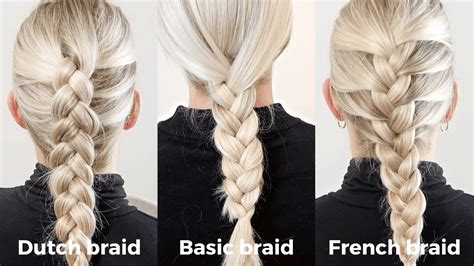What Is a Dutch Braid?
A Dutch braid, also known as an inside-out braid, is a type of three-strand braid where the strands are crossed under each other instead of over. This creates a raised, textured effect that stands out from the scalp.

What Is a French Braid?
A French braid, also known as an outside-in braid, is a type of three-strand braid where the strands are crossed over each other. This creates a flat, smooth effect that blends into the scalp.
Dutch Braid vs. French Braid: Key Differences
| Feature | Dutch Braid | French Braid |
|---|---|---|
| Appearance | Raised, textured | Flat, smooth |
| Location | Stands out from the scalp | Blends into the scalp |
| Difficulty | Moderate | Easy |
| Time Required | 10-15 minutes | 5-10 minutes |
| Versatility | Can be worn in various styles | More traditional, less versatile |
Step-by-Step Instructions
Dutch Braid
- Brush your hair to remove any tangles.
- Divide your hair into three equal sections.
- Cross the left strand over the middle strand.
- Cross the right strand under the new middle strand.
- Repeat steps 3-4, alternating between crossing strands over and under until all of the hair is braided.
- Secure the end with a hair tie.
French Braid
- Brush your hair to remove any tangles.
- Divide your hair into three equal sections.
- Cross the right strand over the middle strand.
- Cross the left strand over the new middle strand.
- Take a small section of hair from the left side and add it to the left strand.
- Cross the left strand over the new middle strand.
- Take a small section of hair from the right side and add it to the right strand.
- Repeat steps 5-7, alternating between adding strands and crossing strands over until all of the hair is braided.
- Secure the end with a hair tie.
Tips for Success
- Use a hairspray or mousse to help keep your braids in place.
- Practice makes perfect! The more you practice, the faster and easier it will become to braid your hair.
- If you have thick or long hair, consider using a bigger brush or comb to help section your hair.
- Don’t be afraid to experiment with different styles of braids. You can incorporate ribbons, beads, or other accessories to create a unique look.
Benefits of Braiding
Braiding your hair offers a number of benefits, including:
- Protects hair from damage: Braids can help to reduce friction between your hair strands, which can prevent breakage and split ends.
- Keeps hair out of your face: Braids are a great way to keep your hair out of your face when you’re working out, playing sports, or simply trying to stay cool.
- Adds volume and texture: Braids can add volume and texture to your hair, making it look fuller and more stylish.
- Improves hair health: Braiding your hair can help to distribute natural oils throughout your hair, which can improve its overall health and appearance.
FAQs
-
Which braid is easier to do, a Dutch braid or a French braid?
French braids are generally easier to do than Dutch braids. -
Which braid lasts longer, a Dutch braid or a French braid?
Dutch braids generally last longer than French braids. -
Can I sleep with my hair in a braid?
Yes, you can sleep with your hair in a braid. However, it’s important to use a loose braid to avoid putting too much stress on your hair. -
How often should I wash my hair if I wear braids?
You can wash your hair less often if you wear braids. However, it’s important to wash your hair whenever it feels dirty or oily.
Conclusion
Dutch braids and French braids are both beautiful and versatile hairstyles that can be worn by people of all ages. While Dutch braids are more raised and textured, French braids are more flat and smooth. Ultimately, the best braid for you will depend on your personal preferences.
